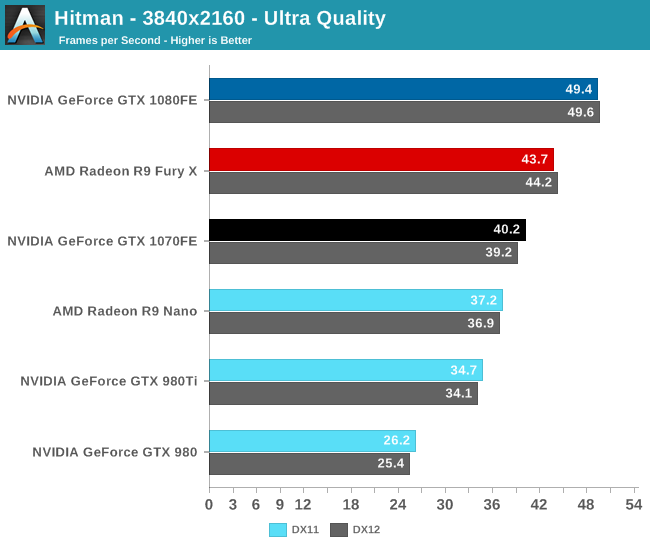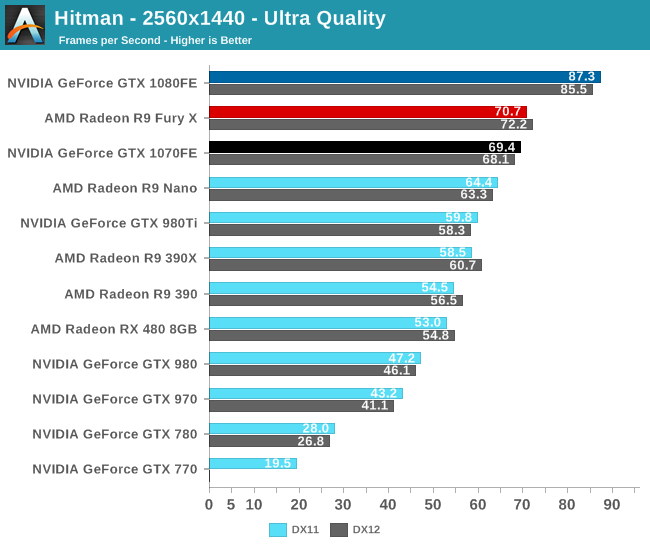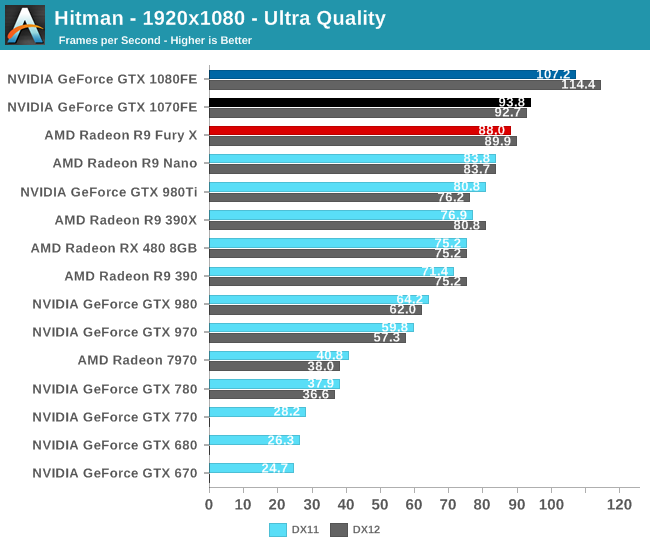The NVIDIA GeForce GTX 1080 & GTX 1070 Founders Editions Review: Kicking Off the FinFET Generation
by Ryan Smith on July 20, 2016 8:45 AM ESTHitman
The final game in our 2016 benchmark suite is the 2016 edition of Hitman, the latest title in the stealth-action franchise. The game offers two rendering paths: DirectX 11 and DirectX 12, with the latter being the case of DirectX 12 being added after the fact. As with past Hitman games, the latest proves to have a good mix of scenery and high model counts to stress modern video cards.



Because Hitman supports both DX11 and DX12, for the moment we’ve gone ahead and benchmarked it with both. In practice the performance impact of DX12 is very mixed; NVIDIA cards prior to Pascal lose performance and Pascal cards can either gain or lose performance. AMD cards on the other hand tend to gain performance. The image quality is the same with both renderers, so it’s simply a matter of picking the render path that produces the best performance for a given card.
In any case, the GTX 1080 continues to top the charts here. 60fps still isn’t attainable at 4K, but it can deliver a reasonably playable 49fps. Alternatively, at 1440p it does better than 85fps. Meanwhile the GTX 1070 isn’t a great option at 4K, but at 1440p it can easily stay north of 60fps, delivering 69.4fps.
Thanks in part to the DX12 code path, this is another game where the GTX 1070 performs as expected versus GTX 1080, but still can’t hold on to second place. Rather the Radeon Fury X takes second place at all but 1080p.
Looking at our generational comparisons one last time, this final game has the Pascal cards performing better than expected. At 1440p and above, the GTX 1080 hits 86% better performance than the GTX 980 under DirectX 11, and the GTX 1070 bests the GTX 970 by an average of 63% in the same circumstances. As best as I can tell, there is just something about the Pascal cards that is slightly more in tune with this game than was the Maxwell 2 cards, leading to the performance we’re seeing here. Otherwise the gap between the GTX 1080 and GTX 1070 is pretty typical at about 25% at the higher resolutions.
Finally, in our last time checking in on the GTX 680, the GTX 1080 offers a commanding performance improvement. GTX 1080 is 4.1x faster than GTX 680 under DirectX 11, reinforcing just how much progress NVIDIA had made in 4 years and a single full manufacturing node upgrade.










200 Comments
View All Comments
DonMiguel85 - Wednesday, July 20, 2016 - link
Agreed. They'll likely be much more power-hungry, but I believe it's definitely doable. At the very least it'll probably be similar to Fury X Vs. GTX 980sonicmerlin - Thursday, July 21, 2016 - link
The 1070 is as fast as the 980 ti. The 1060 is as fast as a 980. The 1080 is much faster than a 980 ti. Every card jumped up two tiers in performance from the previous gen. That's "standard" to you?Kvaern1 - Sunday, July 24, 2016 - link
I don't think there's much evidence pointing in the direction of GCN 4 blowing Pascal out of the water.Sadly, AMD needs a win but I don't see it coming. Budgets matter.
watzupken - Wednesday, July 20, 2016 - link
Brilliant review. Thanks for the in depth review. This is late, but the analysis is its strength and value add worth waiting for.ptown16 - Wednesday, July 20, 2016 - link
This review was a L O N G time coming, but gotta admit, excellent as always. This was the ONLY Pascal review to acknowledge and significantly include Kepler cards in the benchmarks and some comments. It makes sense to bench GK104 and analyze generational improvements since Kepler debuted 28nm and Pascal has finally ushered in the first node shrink since then. I guessed Anandtech would be the only site to do so, and looks like that's exactly what happened. Looking forward to the upcoming Polaris review!DonMiguel85 - Wednesday, July 20, 2016 - link
I do still wonder if Kepler's poor performance nowadays is largely due to neglected driver optimizations or just plain old/inefficient architecture. If it's the latter, it's really pretty bad with modern game workloads.ptown16 - Wednesday, July 20, 2016 - link
It may be a little of the latter, but Kepler was pretty amazing at launch. I suspect driver neglect though, seeing as how Kepler performance got notably WORSE soon after Maxwell. It's also interesting to see how the comparable GCN cards of that time, which were often slower than the Kepler competition, are now significantly faster.DonMiguel85 - Thursday, July 21, 2016 - link
Yeah, and a GTX 960 often beats a GTX 680 or 770 in many newer games. Sometimes it's even pretty close to a 780.hansmuff - Thursday, July 21, 2016 - link
This is the one issue that has me wavering for the next card. My AMD cards, the last one being a 5850, have always lasted longer than my NV cards; of course at the expense of slower game fixes/ready drivers.So far so good with a 1.5yrs old 970, but I'm keeping a close eye on it. I'm looking forward to what VEGA brings.
ptown16 - Thursday, July 21, 2016 - link
Yeah I'd keep an eye on it. My 770 can still play new games, albeit at lowered quality settings. The one hope for the 970 and other Maxwell cards is that Pascal is so similar. The only times I see performance taking a big hit would be newer games using asynchronous workloads, since Maxwell is poorly prepared to handle that. Otherwise maybe Maxwell cards will last much longer than Kepler. That said, I'm having second thoughts on the 1070 and curious to see what AMD can offer in the $300-$400 price range.